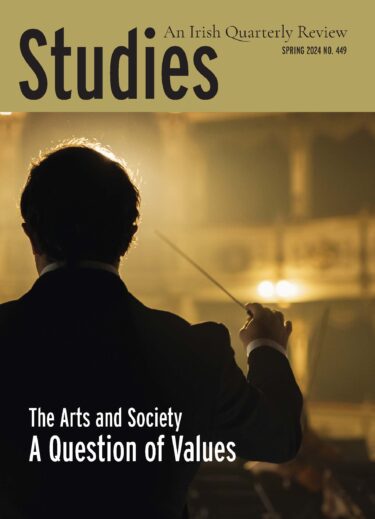Showing all 12 results
Article 27 of the United Nation’s Universal Declaration of Human Rights asserts people’s right ‘to enjoy the arts’ and ‘freely to participate in the cultural life of the community’. It seems fair to say, however, that for most people access to the arts is not near the top of the human rights priority list. Set next to such staples as the right not to be enslaved or tortured or the right to freedom of movement or of expression, it may appear to be something of a luxury item – a desirable thing, no doubt, but hardly essential. And maybe, in any case, it is really only a matter that concerns the few – those who, by virtue of their class, their education, or their spending power, are at home in the world of the arts. Certainly, the arts do not appear to be intrinsically connected to the ordinary life of citizens.
This perspective needs to be challenged. Historically, all of the arts have their source in everyday human experience and creative life. Building dwellings, crafting utensils, painting, making music, telling stories, singing – these have always been essential features of the collective life of communities. In his 1931 Harvard lectures on the philosophy of art, the American philosopher and education reformer John Dewey gave eloquent expression to this sense of intimacy between life and art: ‘Mountain peaks do not float unsupported; they do not even just rest upon the earth. They are the earth in one of its manifest operations.’1 Art is one of the ‘manifest operations’ of communal life. It is an elevation of the things of life, so to speak, but it ought not to be a thing apart. In past times the arts helped to articulate what Charles Taylor calls the ‘social imaginary’ – ‘the ways people imagine their social existence, how they fit together with others, how things go on between them and their fellows, the expectations that are normally met, and the deeper normative notions and images that underlie these expectations’.2 If the connection between the arts and life is severed, the arts lose their potency to evaluate and critique a society’s norms, to process its traumas, and to imagine better futures.
Perhaps the personal poetical crisis that Yeats addresses in ‘The circus animals’ desertion’3 has a bearing on the whole artistic enterprise. In his last years Yeats found that the ‘masterful images’ of his poetry, born out of the real experiences of the heart – love, bitterness, fanaticism, hatred – could no longer bear fruit. He had climbed the ladder from the heart, the world of gritty experience, and developed his images ‘in pure mind’, and now he found himself without inspiration. He finishes acknowledging that he must descend the ladder, return to ‘the foul rag and bone shop of the heart’; otherwise, he would be condemned to doing nothing more than enumerating ‘old themes’ – breaking no new ground, articulating no new insights, no longer contributing language, images and ideas to his critical and creative examination of himself, his society, and the things of the soul.
Dewey’s surmise that there has been a comparable severing of the connection between the arts and life during the last two hundred years is credible. Art became detached from its roots, ceased to be ‘an integral part of the ethos and the institutions of the community’, and was compartmentalised. The new capital generated by the industrial revolution and colonialism gave rise to the proliferation of museums, exhibitions, opera houses and galleries, all now in the service of a new imaginary. Works of art, being rare, were costly, so they came to be emblems of wealth, cultural good taste, and superior status; and their ‘segregation from the common life’ reflected the fact that they were ‘not part of a native and spontaneous culture’.
It is vital to the good health of a society that it resist this segregation in regard both to the performance and to the enjoyment of the arts. Music, literature, drama, and the pictorial arts are among the most crucial tools a society has for recording human experience, articulating new ideas, and, when necessary, calling out injustice and institutional failure. It is true of course that works of art are created within one tradition or another, but this doesn’t prevent them from being interruptive or inventive. Respecting tradition does not entail receiving a body of rules and ideas passively and unquestioningly. It is, rather, about interpreting what is received in the light of the experience, the knowledge, and the imagination of the present – about maintaining a creative tension between fidelity to the past and an openness to innovation. It is in this dialectical face-to-face that the transformative power of the arts becomes evident. As such, it is not a luxury in a democratic society, and it merits recognition and protection as a human right.
***
The transformative power of the arts is the focal point of an elective module offered to students at Trinity College Dublin, called ‘Music-making, the Arts and Society’. It is provided jointly by the Royal Irish Academic of Music and the Department of Education in Trinity. According to the module descriptor, it ‘examines the way in which the arts – music in particular – can address contemporary challenges such as climate change, mass migration, civil unrest, social exclusion, and navigating power relations’. Prospective attendants are told that they will ‘explore ways in which citizens can engage in the arts to engender social change’ and ‘question whether artists have an obligation to serve communities and how they might do this’. Four of the contributions to this issue of Studies are drawn from the work of people involved in teaching on this module. Special thanks are due to John O’Hagan, Professor Emeritus of Economics, Trinity College Dublin, for bringing these essays together. The economics of the arts has been a specialist research area for Dr O’Hagan in recent years, but, as he makes apparent in his own essay here, his interest in the role of the arts in society extends well beyond checking the balance sheet. In ‘“The Subsidised Muse”: The Case for State Funding of the Arts’, he argues that large direct public funding is justified not primarily because of the undeniable personal benefits it generates, but because it brings a range of substantial societal benefits. He notes that the arts help to protect the identity and enhance the prestige of nations and regions, which has the effect of creating stability and cohesion. And more: this cohesion is enhanced by the ‘on-going social criticism function of the arts’ by which it contributes ‘in a special way to a functioning democratic liberal society’.
The other papers in this series also concern the wide-ranging personal and societal benefits of the arts. In her ‘Reflections from a Twenty-First Century Conservatoire Leader’, Deborah Kelleher, Director of the Royal Irish Academy of Music (RIAM), describes the RIAM’s commitment to promoting access and inclusion in music education and participation, particularly in relation to young people and adults with disabilities. She notes that access and inclusion have been objectives of the RIAM since its foundation in 1848. In ‘Trinity College Chapel Choir: Profiling Chorister Perceptions’, Kerry Houston and Marita Kerin trace the history of chapel music in TCD, right back to the early years of the college, which was founded in 1592. But the substantial theme of their essay is the findings from a study that investigates how current students view the musical, spiritual, and social aspects of their experience as choristers. Most of the survey respondents were in agreement that the Chapel Choir played an important role in creating social cohesion on campus, helping the students to make cross-disciplinary connections and friendships, and building strong bonds of collegiality. And in the last of the essays in this series, ‘The Prison Service and the Arts: Impact and Emerging Debates’, Sarah Doxat-Pratt evaluates the impact of externally organized, participatory arts projects, particularly relating to music and drama, in prisons and community justice settings. One key purpose of this activity, she writes, is ‘to go some way to mitigating the pains and harms of imprisonment’. The projects bring many benefits. These include providing the participants with purposeful ‘occupied time’, fostering a positive attitude, creating a space for their emotional expression, and helping them to develop personal skills and capacities. Dr Doxat-Pratt also notes that some arts projects in prisons use their work to highlight inadequacies and inequalities in the prison system and to help train frontline staff.
***
The remaining essays in this issue cover diverse themes. In a lengthy paper on John Henry Newman’s ‘campaign in Ireland’ to establish the Catholic University, Paul Shrimpton reviews the evidence provided in Newman’s voluminous personal papers from his time as Rector. He argues that they serve to undermine various negative portraits of Newman, by recent as well as older scholars, in relation to the university, and especially with regard to Newman’s relations with Archbishop Paul Cullen. Newman’s papers also serve to show him, contrary to a common caricature, as a ‘man of action’. They demonstrate, Dr Shrimpton says, Newman’s ‘psychological toughness as he set up and then ran a university almost singlehandedly’ and sought to navigate a path through the political and social complexities of Ireland.
In another lengthy essay, Suzanne Mulligan addresses the subject of sexual violence against women. Her premise is that ‘we cannot understand the underpinnings of gender-based violence without first considering the values that shape the world we inhabit. Thus, she proposes a virtue-ethics approach to questions of Catholic sexual ethics. How we frame our social narratives affects deeply our understanding of personhood and human dignity. Prevailing social narratives and the value system that underpins them need to be thoroughly re-examined.
In ‘On Retreat with the Jesuit Pope’, journalist and papal biographer Austen Ivereigh portrays his various collaborations with Pope Francis and provides the background to a set of talks he delivered for an eight-day Spiritual Exercises retreat of the British Jesuit Province. He followed closely the themes which the pope has made the leitmotifs of his pontificate, asking himself as he prepared the talks, ‘How does [Francis’s] pontificate express the journey through the Four Weeks of the Exercises? How do the Exercises illuminate the pontificate, and vice-versa?’
Also on the theme of Pope Francis’s vision is Gerry O’Hanlon SJ’s ‘The Synodal Pathway of the Catholic Church: Progress and Challenges’. He asserts that for the pope synodality is much more than a mere ‘system of governance’; it is a way of being Church. He then takes stock of where things lie on the synodal pathway and judges it too soon to assert that it will mark a decisive paradigm shift.
In the first part of a two-part essay, Peadar Kirby argues against the tendency to condemn and dismiss the far-right without attempting to understand them. Examining neoliberalism’s ‘reconfiguration of power’, he argues, ‘offers a more substantial way to understand the reasons for the rise of the far-right as well as prescriptions to address it’. He endorses Pope Francis’s insistence, in Fratelli Tutti, that what is needed is the forging of ‘a common project for the human family, now and in the future’.
This issue of Studies also carries the work of two Irish poets, one poem by Desmond Egan and a set of four poems by Fred Johnston.

